Since this guide was last updated (March 2024), Google has started rolling out parts of this experiment, beginning with AI Overviews. However, more updates from Google Labs are expected. Consider this guide a snapshot, providing a look back at the different SGE experiments to prepare for what Google may roll out to the SERPs for the general public.
Is Google’s Search Generative Experience the end of SEO or just a flash in the pan? Or is it something in between those extremes?
In this special Point of View guide, I will cover what we know about Search Generative Experience, how it might impact search, and how you can prepare for it. If you want to get right to our recommendations, skip down to “How to Prepare for Search Generative Experience.”
Note: On May 14, Google rolled out AI Overviews (AIO) in public search after testing it within SGE. Learn about AIO, its impact on SEO, how to track it, and more.
Prefer video? Watch our webinar on Google's Search Generative Experience here:
Note: This webinar was recorded in June 2023.
Table of Contents
- What Is Search Generative Experience?
- What Does Search Generative Experience Look Like?
- How Are SEOs Reacting to Search Generative Experience?
- What Does Search Generative Experience Mean for SEO?
- How to Prepare for Search Generative Experience
- Why Aren’t SGE Responses Great (At Least for Now)?
- Conclusion
What Is Search Generative Experience?
On May 10, 2023, Google announced it would be releasing a limited beta version of an integration of generative AI in its search product. The new chat-style search result would be known as Search Generative Experience (SGE).
SGE uses generative AI, the technology behind advancements like ChatGPT, to create short essay-style answers to a search query, with suggested sources for more information, suggested follow-up questions, and sometimes other features (such as a product carousel for some shopping-related searches).
It doesn’t replace traditional search results but appears above them. A user can still scroll down to view the SERP we’ve all been used to.
SGE now also provides the ability to generate text and images. So you can type in a prompt like you would in ChatGPT, and you'll get the result right on your search page.
As of November 8, 2023, the beta version of SGE has expanded to over 120 countries and territories and has added support for four new languages.
Check out our 6-minute seoClarity short for 5 research-backed SGE insights all SEOs should know!
What Does Search Generative Experience Look Like?
I got access to the limited test of SGE in Google Search, and I’ll share my observations here.
How it shows up in SERPs
When SGE is active for a query, it typically first appears at the top of the results page with a button offering to generate an “AI-powered overview” for your query.
In the days following the release of SGE to those of us on the waiting list, it was widely reported that SGE responses stayed out of the way unless the user clicks the Generate button. However, that has not proven to be the case. I’ve noticed that if I start opening SGE regularly, it starts opening on its own in subsequent searches.
Around November 2023, Google also started experimenting with a partial expansion view of SGE. Rather than presenting the fully expanded SGE result, it includes a partial view with a "show more" button that you can click if you want to see the full result.
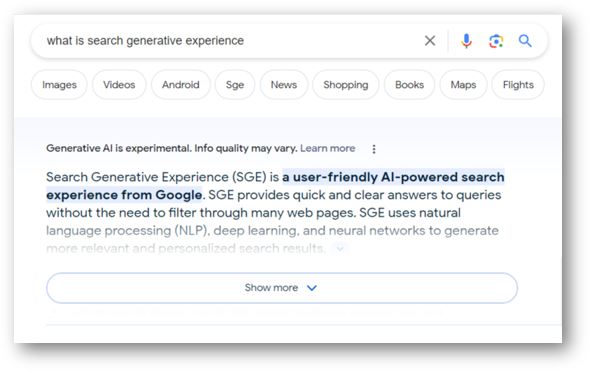
This development could be an attempt to compromise with those who don't like how far you have to scroll to get to the traditional web results when the full SGE result shows up.
This partial display seems to be coming up pretty consistently now both on desktop and mobile.
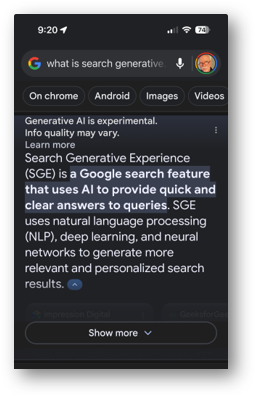
If you click the "Generate" button or "show more" in the partially expanded view, a larger space opens above the regular search results for your query with the AI-generated response.
Originally, the result looked something like this:
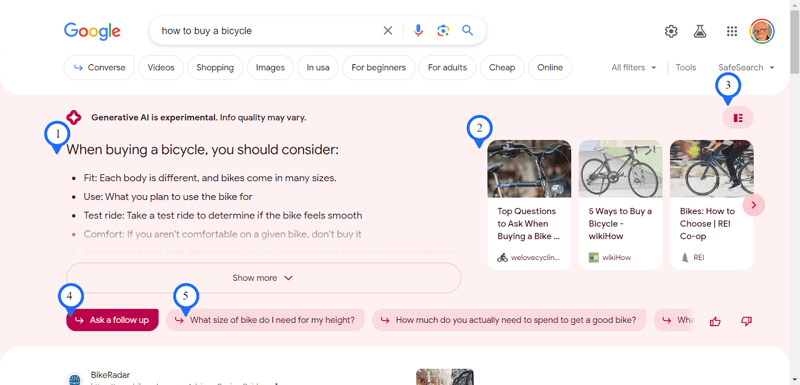
These results consisted of the following main components:
- The AI-generated text response
- A carousel of selected sites with more information on the topic. Google has told us some of these are likely the sources for the generated response, but not all of them. On mobile, this carousel appears below the generated text.
- A detailed sources icon. Clicking this expands the generated text with more web sources for some of its sections or points. See an example below.
- “Ask a follow up” allows you to ask any question you want about your topic. SGE knows what it’s already told you so can answer in context.
- A carousel of suggested follow-up questions.
The ability to ask follow-up questions was touted in Google’s announcements as a standout feature of SGE. They seem to want to position the feature as being most useful for taking a deep dive into a topic.
Here’s what the expanded detailed sources view looks like:

Recently, however, SGE responses have changed a bit and now look more like this:
As you can see, there is no longer a carousel of suggested sites to the right. Instead, they either open by default or you have to click the down arrow at the bottom to see them.
Want to know how SGE impacts the real estate industry? Check out our comprehensive research study and stay tuned for our analysis of other industries in the future!
Ecommerce in SGE
The first thing to note is when the query has clear commercial intent, Google still puts its sponsored shopping carousel at the top.
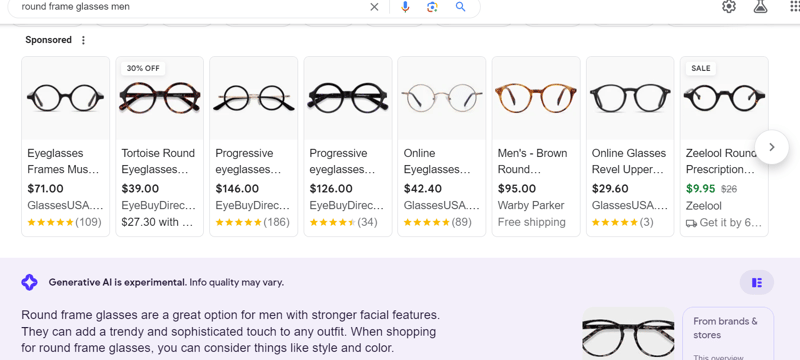
The product links in the generated response though are somewhat unique, not matching entirely with either Googles sponsored or organic shopping results.
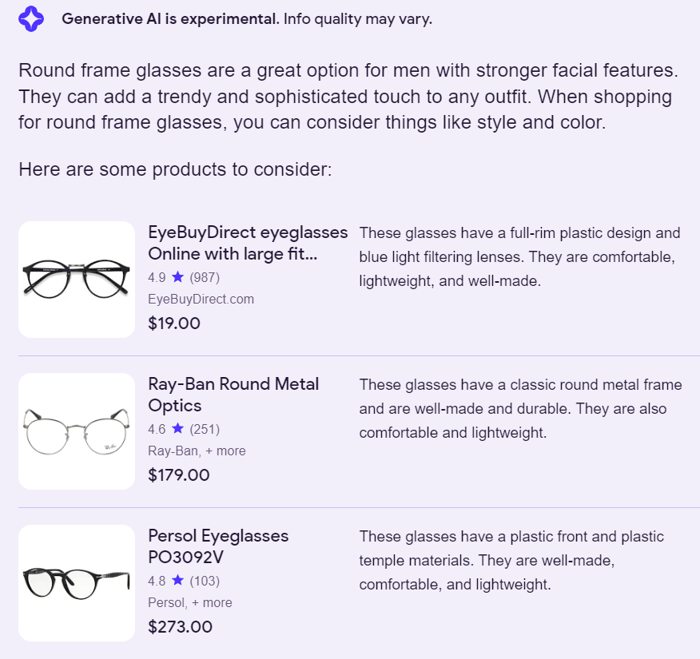
What’s more, Kevin Indig noted, “Google seems to pull these product attributes from written reviews on websites, which is quite stunning because Google turns unstructured into structured data” (emphasis mine).
However, unlike traditional product listings, these suggested products are not tied to a particular retailer. Instead, when you click on one it opens a sidebar with further filters and multiple buying options.
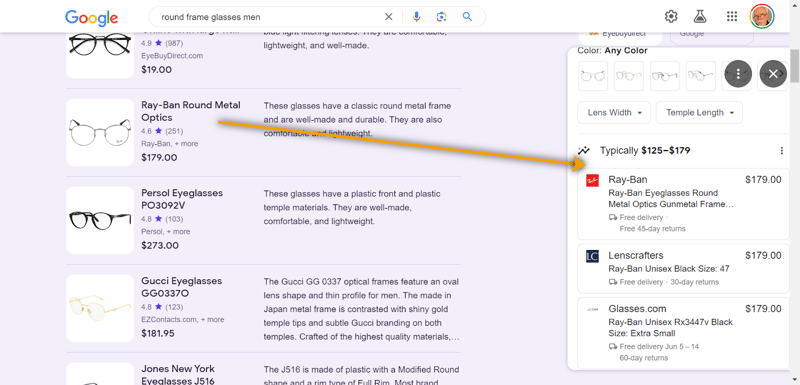
And for local shopping results, SGE brings back the Five Pack!
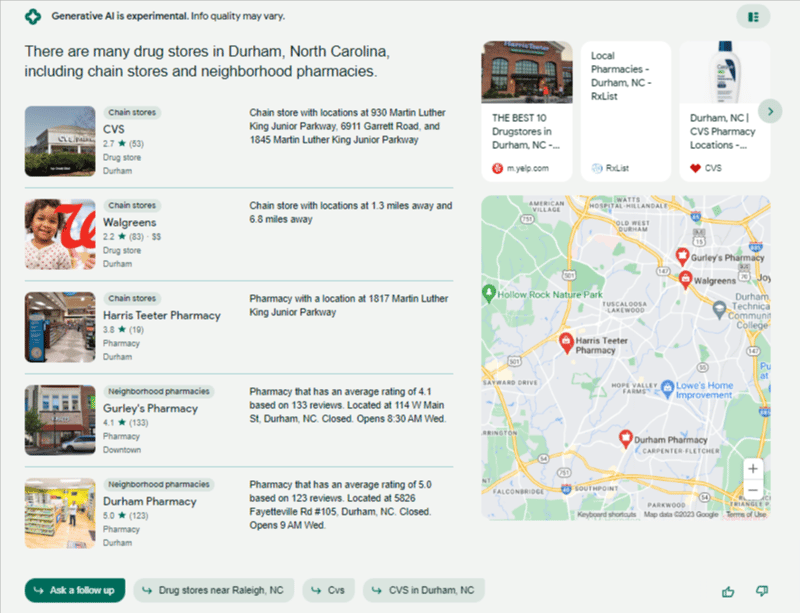
UPDATE: As evidence that Google is actively adjusting and tweaking SGE, I did the same local search a day later and did not get offered an SGE result like I showed above. On some other local queries I did get an SGE result, but without the map pack formatting.
Shows More Often Than Predicted
One of the first things I noticed after getting access to Search Generative Experience was that it shows up for a lot more queries than I thought it would. Like many other SEOs, I had assumed it would only be used for more complex, longer tail queries where a more complex and nuanced answer might be warranted.
But I’d estimate it shows up for more than 90% of my searches, even in many cases for YMYL (Your Money/Your Life - sensitive topics such as finances and health). For example, this response to the query “do I have cancer?”
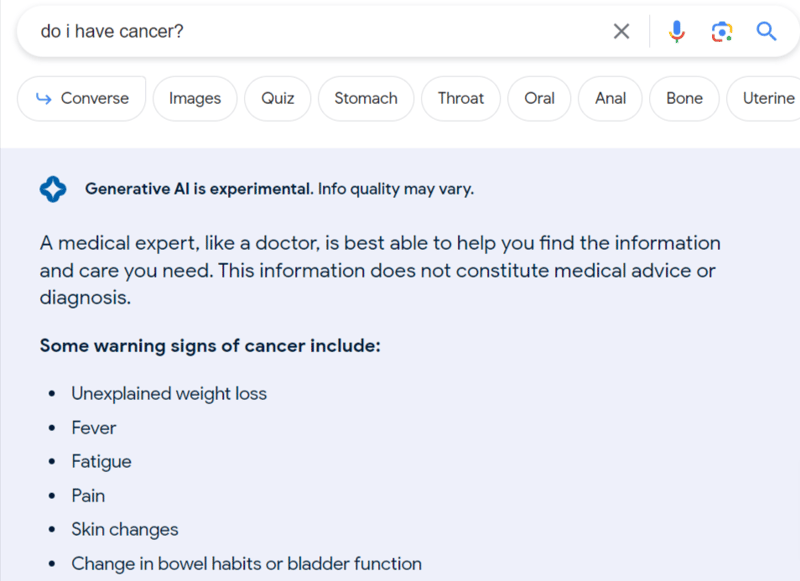
Note though that there is a disclaimer at the beginning of such a response that goes beyond the stock disclaimer at the top of every SGE response.
How Are SEOs Reacting to Search Generative Experience?
I follow several hundred professional SEOs across Twitter, LinkedIn, and a number of private search forums.
The reactions to SGE in this sample of people who either, like me, have beta access, or who have reviewed our sharing of the experience, is mixed, but has been skewing towards unimpressed to outright negative.
In response to such feedback, the stock answer of Google’s Danny Sullivan has been to reiterate that SGE is an experiment, still in its infancy, and that they appreciate and are listening to all feedback.
Common Criticisms of SGE
It’s mostly “Meh.”
The most common criticism of Search Generative Experience is that most of the answers are underwhelming. That is, they don’t often rise above the kind of rudimentary content that might be expected from a copywriter hired on Fiverr.
In many cases it simply produces bullet lists without much detail. Asking a follow up question often provides more detail, but nothing that anyone would mistake for expert-level content.
At an extreme, some are accusing Google of creating content on a quality level that Google itself penalizes sites for. Some have even called it Google’s “content farm.”
No analytics
Many SEOs worry whether Google will share any data about SGE results, in particular impressions and clicks on pages featured as sources or follow-up material. This fear seems warranted since Google has been reluctant to share such data on other SERP features.
Sites featured, but will they click?
While SEOs were relieved at first that Google did include clickable links to website pages relevant to the topic, they noted that only a very few are easily visible. You have to scroll the carousel or click the detailed sources button to see more, but how many users will know or be prone to do that?
Furthermore, it is unclear how these sites were chosen. Often many of them match the top-ranked results in the regular SERP for the query, but not all of them are. It is clear that SGE is using its own algorithm to select its recommended sources.
As of November 2023, Google began testing out (at least on mobile) auto-expanding the sources for SGE results. This is more of a featured snippet-like result since the user doesn't have to tap to see your site as a source, giving your content a better chance of getting clicked.

Plagiarism
The most extreme criticisms of SGE, however, center around many examples where it appears to have lifted entire passages of text directly from websites, with attribution that might be unclear to the average user.
In this example, shared by Rebekah Edwards on Twitter, you can see that the opening bullet list is identical to the text in the featured snippet below it, meaning that it was taken from the Rejuvenation Dentistry page linked in the featured snippet.

Google Search Liaison Danny Sullivan explained that the first of the link tiles in the carousel is the source of the quotation, but Edwards and others retorted that, unlike a featured snippet, the source is not evident to the average user, nor is it even clear that this is text completely copied from a third-party site.
Some are calling this outright content stealing and plagiarism.
These critics note that Bing’s AI chat in search, in contrast, lists sources like footnotes in the text itself, making clear where each piece of information came from.
It strikes me, as someone who has made extensive use of ChatGPT and other generative AI tools, that these SGE responses don’t even look like true generative text.
Recommended Reading: Cracking the Code: 5 AI Strategies to Apply in Enterprise SEO [WEBINAR]
Generative AI, though trained on outside content, is supposed to create an “original” response by generating its own text based on its ability to predict the next most likely word (actually, token, which can be a group of words).
But in many responses, SGE seems to just be taking clumps of text whole cloth from several sites and piecing them together.
Here’s an example from Cyrus Shepard on Twitter. When asked “how to boil eggs,” SGE gave a nonsensical, self-contradictory answer that Shepard calculated would have you cooking the eggs five separate time for 60 minutes of cook time!
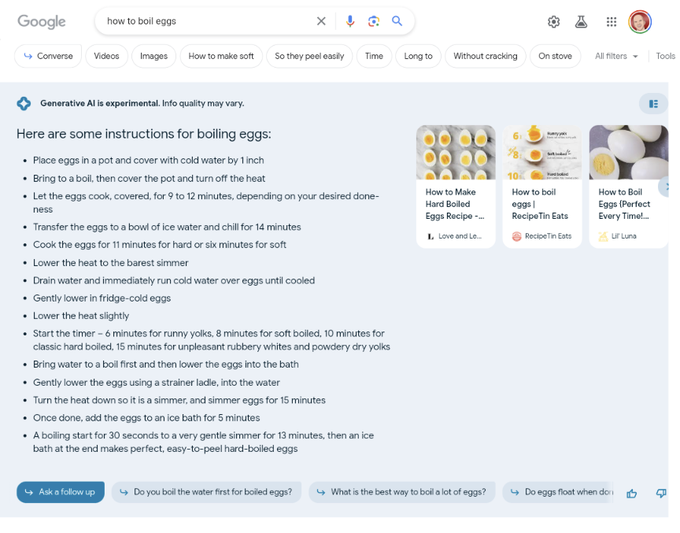
When you click through to the linked sources, it’s obvious SGE just grabbed the instructions from several of them and threw them together.
Curiously enough, this experience does not match what we were shown in the demos for SGE at Google I/O, which seemed to have more sophisticated generated responses.
What Does Search Generative Experience Mean for SEO?
SGE has its own disclaimer at the top of every one of its results:
Generative AI is experimental. Info quality may vary.
So allow me to preface this Point of View section with my own disclaimer: “Mark’s answers are experientially-based. Predictive accuracy may vary.”
That said, I think we’ve seen enough that, combined with decades of experience with Google’s developments in search, we can make some educated guesses about the potential impact of Search Generative Experience on organic traffic.
Recommended Reading: Generative AI's Impact on SEO
The Big Question: Will People Even Use It
If SGE is a threat at all, it can only be a threat if regular users actually…use it.
Right now, I’d speculate that the vast majority of users who signed up for the Google Labs waiting list and got access are from three groups: SEOs, tech enthusiasts, and journalists. These are not typical search users.
We beta testers are highly motivated to use the generative search to see what it can and can’t do. But will more typical searchers want to use it?
I would venture that in its present form, probably not.
For one thing, it’s slow. It typically takes several seconds to start generating an answer. By that time the typical user will have scrolled down to see what’s in the traditional results.
Also, the answers it gives are not very satisfying, at least so far. See examples below…
I remember the panic that spread through the SEO community when featured snippets first appeared. Though “SEO is dead” has been falsely cried so many times it’s everyone’s favorite headline to satirize, featured snippets looked to be the thing that could finally do the deed.
Just as some are saying with SGE, if the featured snippet provides the answer, why will anyone click through to a website?
It is true that the wider category of Google Answer Boxes killed off a great many of the commodity information sites (What time is it? What’s the temperature? What’s 247.6 times the square root of 111?).
But for the kind of information featured snippets show, it turned out in a great many cases that users did want to click through to learn more. That’s why you can find so many posts and conference talks about getting into featured snippets as a strategy.
I think we could see similar behavior with SGE results once they roll out to regular searchers.
The Trust Factor
Another reason why SGE might not be as big a click stealer as some SEOs fear is the question of whether people will trust its answers.
Whenever I’m asking generative AI questions that have factual answers, I feel a little uneasy about going with its answers. I think this wariness comes from not knowing the sources of the answers it gives.
If I’m doing a search for anything that matters to me, I usually want to scan results for a website I already trust, or at least one that looks like I might trust it.
But with SGE and other AI-generated answers, I have no basis on which to vet the trustworthiness of the answer.
If users seek to verify the SGE responses, they may click the recommended sites or scroll down to the traditional results to corroborate what SGE tells them.
But What If They DO Use it?
All that is speculation about unpredictable human behavior. So let’s say users en masse do decide to rely on SGE answers and start using it regularly. Is that a disaster for organic search traffic?
It certainly could be. It might be that the Answer Box effect (relying on Google answer boxes for commodity information like the time) will extend to many SGE results, and users will then not click on any outside sites.
That would certainly have a negative impact on organic search traffic for many sites.
However, I think even in this case the impact will depend on the type of query.
I would expect traffic to go down for a broader range of informational or top-of-funnel content, the expansion of the Answer Box effect I noted above.
However, in many instances, a user may not value or trust the SGE's response to a more complex query beyond just 'what is the time?'. Therefore, they may still desire to click through to a website for additional information or confirmation — the featured snippet effect.
Since I doubt we’ll get data in Google Search Console that separates impressions and clicks from SGE, we’ll probably need to examine overall traffic that rose or declined after a more widespread release of SGE to back-engineer what types of searches it affects most, if any.
Why Google Can’t Afford to Steal All the Clicks
I think the fears of those saying SGE will rob nearly all traffic from sites and turn Google search results into a zero-click wasteland are unfounded.
Google realizes that to run SGE it needs content, both to train its Large Language Model on and to recommend for users wanting to explore more or vet SGE’s responses. If there are fewer clicks to sites from search, publishers lose the incentive to keep creating such content.
Thus there is a delicate symbiotic relationship between Google and websites, and Google knows they upset that to their own detriment.
Boon for Shopping and Local?
Based on how shopping and local results appear, as shown above, I would expect SGE to actually be a traffic generator for many sites.
SGE provides a much richer shopping experience than the current SERPs do, with the kinds of options and features that draw people to Amazon, such as offering a wide selection of products and variations and an array of filters to help narrow down choice.
The ability to ask detailed follow-up questions to further narrow down one's choices might also be attractive to shoppers, and another factor to keep them from going to Amazon first when ready to shop.
As for local results, as shown above, SGE provides a richer experience than the current Map Pack results, with slightly more choices featured.
How to Prepare for Search Generative Experience
Before offering a point of view on how enterprise SEOs should prepare for SGE, I need to repeat my disclaimer: “Mark’s answers are experientially-based. Predictive accuracy may vary.”
We should keep in mind that it is highly likely that the quality and operation of SGE results will evolve and improve significantly before they are incorporated into public Google search. So it’s a little dangerous to base any strategy too heavily on what we see today.
But there are enough hints in the present version that combined with the aspirational version we saw at Google I/O, I think we can offer some useful advice.
Success Breeds Success
My first take is that if you have been successful in steadily growing organic search traffic for some time now, you are probably in good shape for the advent of SGE.
It’s likely you’re already doing the things that will make it more likely Google will use you as a recommended source in its SGE results. That is, you are displaying the attributes of E-E-A-T (Experience, Expertise, Authoritativeness and Trustworthiness) that Google is looking for in content it wants to recommend.
Also, ranking high in organic results might still be important. As is the case with featured snippets, even when an SGE answer is present, many users may still want to browse the regular results for more information or corroboration.
Enrich Your Shopping Experience
Given SGE’s highly enriched shopping experience, I strongly recommend enhancing the shopping experience on your site to be more attractive for SGE inclusion.
While apparently SGE can understand and make use of product information even when it is unstructured, making use of structured data can only make your product listings more useful and attractive to Google.
seoClarity provides unmatched capabilities to help you build product structured data, even at the massive scale of millions of products.
- Our free Schema Builder browser extension.
- ClarityAutomate™️ Schema Optimizer - Implement, validate, deploy and measure structured data across any number of pages
I’d also recommend improving your product descriptions. Chances are most of your competitors (and maybe you, too?) are using the stock descriptions from product manufacturers. Having unique descriptions can make you stand out in product listings.
Of course, creating those at scale across thousands or even millions of products is daunting. Watch for the release in seoClarity of an implementation of our generative AI assistant, Sia (seoClarity Intelligent Assistant) that will be able to automatically generate and implement more engaging product descriptions.
Here’s an example of how generative AI (think ChatGPT) can make a prosaic, dull product description come to life:
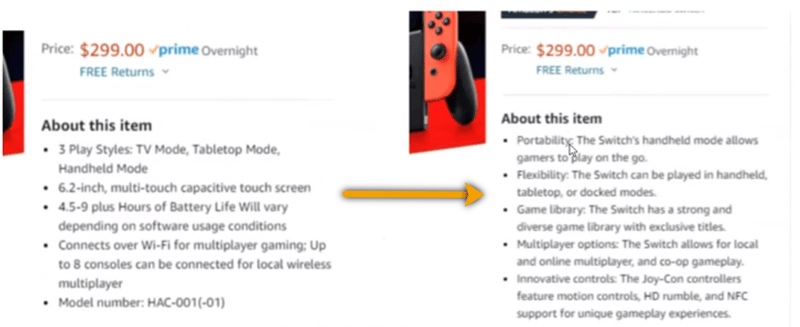
Recommended Reading: 6 Ways to Use ChatGPT and AI for Enterprise SEO
However, there is potential trouble in paradise, at least for brand retailers. Quoting from a tweet by Aleyda Solis:
Google is generating a PLP [Product Listing Page] like experience in the SGE snapshot directly, with an overall product description and showing the relevant brand products directly there in a clickable product carousel like format... but when you click on any of the brand products, it shows a product knowledge panel that won't only show results from the PDPs [Product Detail Pages] of the "brand" site, it will show also PDPs from any online stores/distributors/etc. that also offer those brand products and optimize their feeds/structured data well to appear there.
Now that commercial, mid-funnel, branded organic search traffic that used to go to major brand retail PLPs? A good share of it will be spread across its own PDPs as well as third party online stores PDPs that offer them and optimize them well
Ecommerce: This is the time to optimize your PDPs!
Tl;dr - SGE may actually have the biggest benefit for competitive resellers. Brands may find themselves having to be more competitive (both in pricing and attractiveness of their offerings) even when people search for them by name.
Deepen Keyword Research
In the AI Age of search, merely matching your keyword to a search query is no longer enough. Google is now able to understand your site and the content of your pages in deeper ways that allow it to do much more sophisticated matching or content to a user’s intent, search journey, and more.
You need to do the same.
Your keyword research should go beyond merely evaluating search volume and keyword difficulty to discovering the intent, topical galaxy, audience characteristics, and place in the buyer’s journey for every keyword.
Fortunately, if you’re an seoClarity user, we’ve got you covered here!
Topic Explorer shows you related topics ranked by Intent Similarity™️, an analysis of the audience overlap with your target keyword.
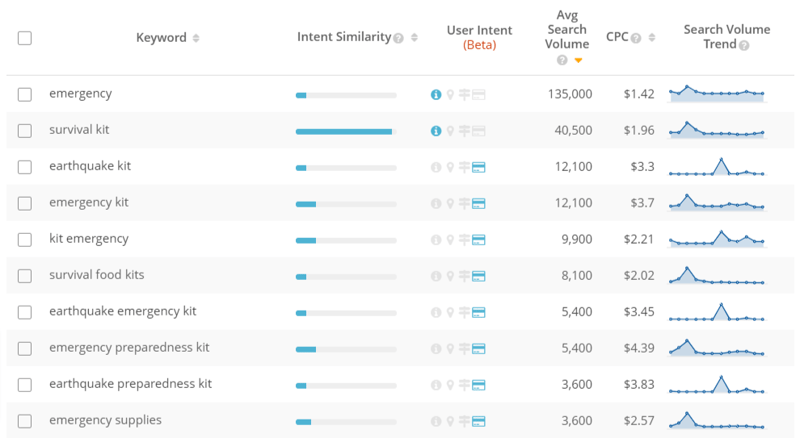
But that’s not all. Sia (seoClarity Intelligent Assistant) gives you audience demographics, the top related topics, and the searcher journey (what people search most before and after your keyword).
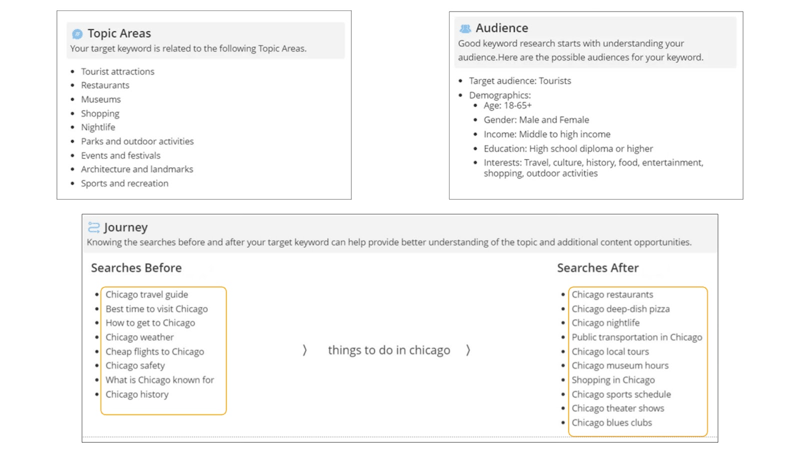
Armed with this information, you can create topic clusters around your main topics, covering all relevant topics, search intents, and levels of your prospects’ journeys to purchase.
Why does that matter for Search Generative Experience? With SGE users can drill down to get to their specific needs and desires. Google will be hungry for recommended content at every level of such explorations.
Freshen Up Titles, Meta Descriptions and Images
SGE displays its recommended sites in tiles with rich information. Make sure you have titles, descriptions, and images optimized to attract clicks.
How can seoClarity help here? It enables you to implement new titles and metas at scale across any number of pages. But also Sia in Page Clarity can help automatically create better, more engaging titles and descriptions for your pages.
In the example below, the “Recommended” column shows Sia’s auto-generated improvements for this page’s title and description.

Beef Up Your Content
SGE will be looking for richer, more complete content that exactly matches the more specific intents and interests of the queries it handles.
We recommend using AI assistance such as ChatGPT to get suggestions to enrich your content, making it more engaging and relevant. Never let AI replace your own writing, but it can be a valuable aid in making suggestions and providing examples.
seoClarity’s Content Fusion incorporates generative AI technology to assist your writers in improving content, creating outlines and suggested text for sentences and paragraphs, while also recommending the topics to include to ensure authoritativeness, and other helpful suggestions for content optimization.
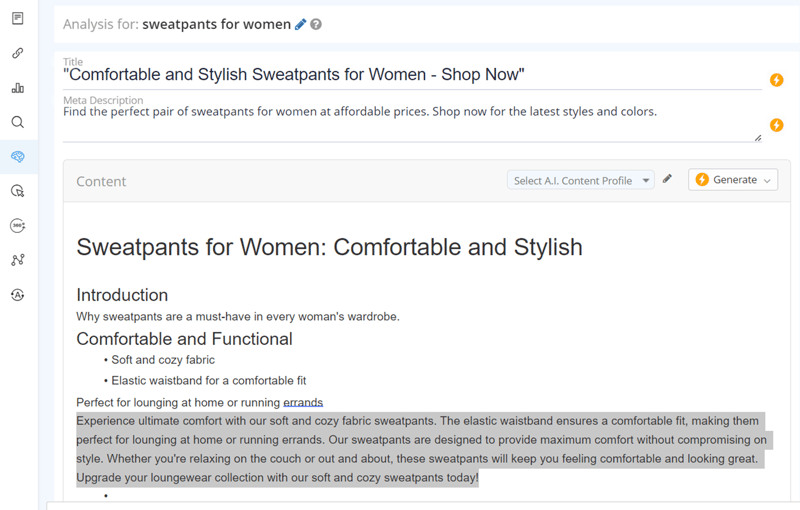
Why Aren’t SGE Responses Great (At Least for Now)?
If I had to guess why this is the case, I’d say that in preparing to put SGE out even to a limited group of users, Google decided to adopt a super cautious approach. Anyone who has closely followed the developments around Generative AI since the introduction of ChatGPT knows of incidents where (sometimes dangerous) misinformation was created or privacy breached.
For that reason, we at seoClarity developed an AI Manifesto, a set of principles we live by as we incorporate these technologies into our platform.
Google knows it has to be very careful about creating a source of possible misinformation or “hallucinated” content in its search results. So I think they’ve decided, at least for now, to take the more conservative route of trying to identify a limited number of trusted sources and simply use their content.
But that has caused me and others to call SGE so far as little more than a sort of expanded featured snippet, only with less clear attribution.
Conclusion
Google Labs access to Search Generative Experience has given us an almost unprecedented opportunity to kick the tires of a potential major change to the way search results are presented long before they go live to the public. I hope my exploration of that experience along with my suggestions have been helpful.
Much remains unknown, but we have evidence that Google is listening to and weighing in the concerns and feedback of SEOs and others concerned about the impact of chat-based search on both users and their own sites.
As a major enterprise SEO platform, responsible to many of the largest sites and brands in the world, we look forward to providing our clients with the ability to track the presence of SGE and correlate how its appearance affects their performance, as well as providing the tools they need to take best advantage of it.
If SEO is a primary concern for you, you should be paying careful attention as this technology and implementation develops. We’ll be sure to keep you informed!
Want more SGE updates and insight into when it might be rolling out to the public? Check out our blog on "What’s Next for Google Search Generative Experience?"
<<Editor's note: this post was originally published in June 2023 and has since been updated.>>





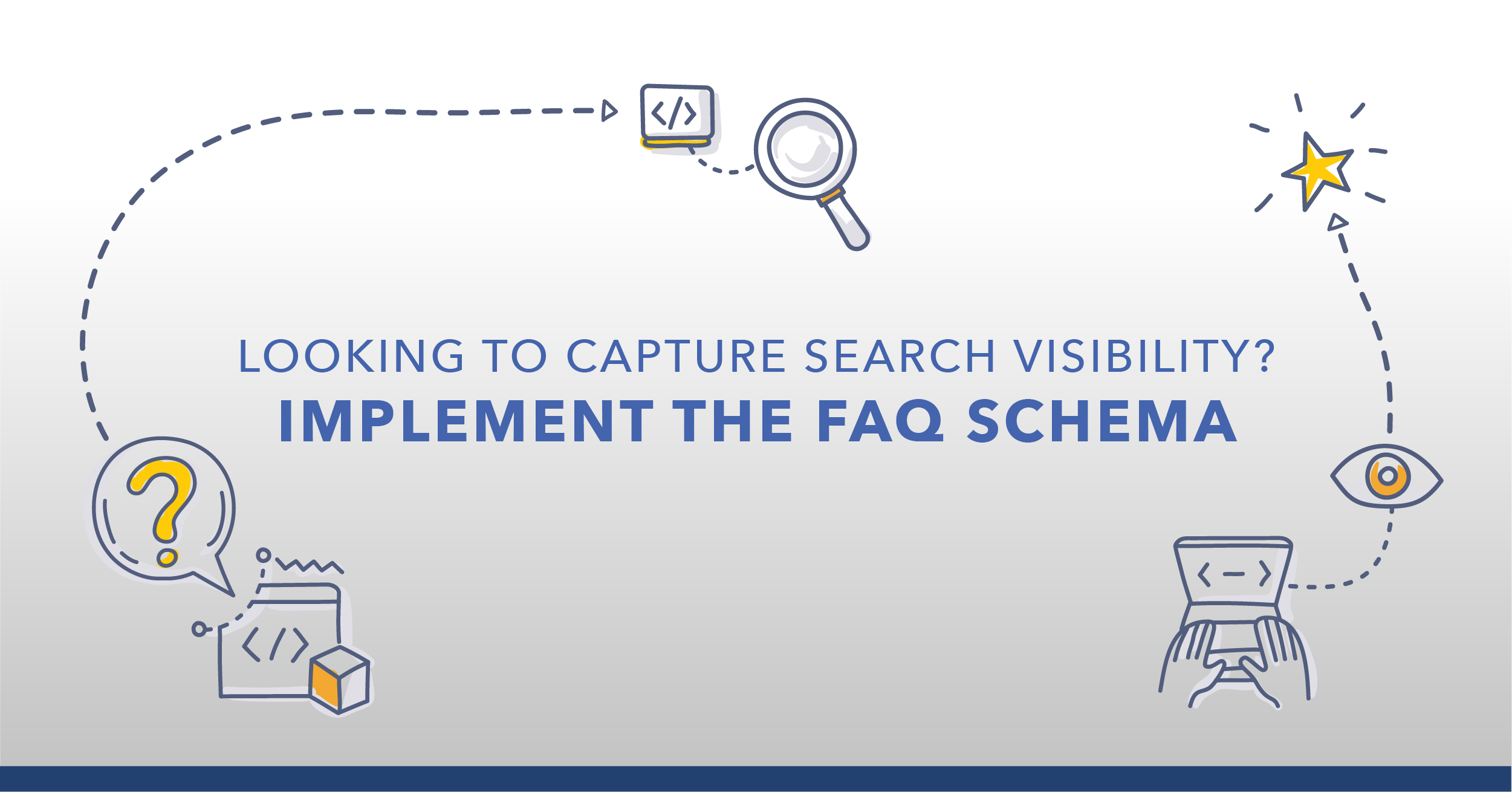

Comments
Currently, there are no comments. Be the first to post one!